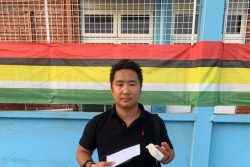Dear Editor,
Like I have said before, the naming of Caribbean Airlines (CAL) as Guyana’s flag carrier was shrouded in secrecy and ill advised. And just a few months later airfares between Guyana and Trinidad are at an all-time high of US$450 round trip; and to New York it’s US$1400. There is no quick and easy solution to the gloomy state of Guyana’s aviation industry and the game that CAL is playing.
The Guyana government and its flag carrier, CAL, are now at odds with each other. Recent headlines in Guyana read: “Government contemplates taking CAL to Caribbean Competition Commission -for high airfares, ridiculous re-checking of passengers: ‘We are not anybody’s eye pass’ -Ali.” (Minister of Tourism)
An airline official said that one of the problems in Guyana is the fuel price. It is US$4.80 a gallon and with this price for fuel you can’t make money. In some parts of the United States it is US$3.00 and in Suriname it is US$3.30.
This coupled with the drug problem at the Guyana Cheddi Jagan Airport and baggage theft will continue to plague the government’s ambitious project of turning Guyana into a regional hub with a $US 150 million airport expansion and upgrade.
The CAL subsidy hurts the Guyana aviation industry and will put other airlines out of business or drive them out of Guyana. CAL drastically increases its airfares out of Guyana when there is no competition, and conveniently lowers its fares when there are other airlines flying similar Guyana routes. This sort of predatory pricing will drive airlines out of Guyana, airline officials alleged.
Another problem with CAL is its lack of flexibility and appreciation of the Guyana market. Take for example when one buys a round-trip ticket to Guyana via Port of Spain, and decides to stop over there for a few days, they can’t continue with 2 pieces of luggage to Guyana. They are told that only one is allowed, but no one is willing to listen to the Guyanese passengers who originated from North America. The policy makes no sense. In addition, the stop-over cost increases the price of the ticket tremendously because one must pay for an additional ticket to Guyana instead of paying a stop-over charge. All these issues should be addressed by the Guyana government. This sort of practice by CAL does not encourage tourism in Guyana.
It’s been over a decade now that the Cheddi Jagan International Airport has been a Category 2 airport. In 2002 a FAA release said: “The U.S. Department of Transportation’s Federal Aviation Administration (FAA) today announced that Guyana does not comply with international safety standards set by the International Civil Aviation Organization (ICAO), thus giving the country a Category 2 rating following a reassessment of its civil aviation authority.” It looks like the Government of Guyana is depending on CAL to bring the airport to Category 1 from recent news in the media. Strangely, why would CAL care to help when this does not really affect them and they seem to work always to monopolize the Guyana airspace? Neighouring Suriname’s Johan Pengel Airport (JAP) is an FAA Category 1 airport.
The government’s unrealistic dream of a Guyana tourism industry needs a reality check. And with such small traffic compared to Haiti, Trinidad, Dominican Republic or Jamaica, topped off with the highest aviation fuel cost in the region, as well, add Caribbean Airlines’ subsidy from the Trinidad and Tobago government. This all adds to up one thing, Guyana has little to offer.
Any sort of tourism for Guyana, besides expatriates visiting friends and relatives, will have to tap into the Suriname and French Guiana market. Guyana and Suriname will have to market themselves as one, to develop their aviation and tourism sectors.
So how is the PPP going to make Guyana a hub between Africa, Brazil and North America when aviation fuel in Guyana is the most expensive in the region and the Guyana market is rather small? Look at the situation, only three airlines serve Guyana currently and they are all from the Caribbean. But we hear of Air China being courted by the government? This is not feasible. They have been talking to JetBlue for five years now and JetBlue is about to enter the Trinidad market. Now we hear that discussion is underway with COPA of Panama, GOL of Brazil and Aero Mexico. It should be noted as well that COPA’s airfares to the Caribbean and North America are pretty expensive.
Surinam Airways (SLM) is still interested in the Guyana-New York route and so far has the best in-flight service in the region. SLM has just acquired a third Boeing 737 and will expand the transatlantic fleet next year. But the future expansion of SLM in the Caribbean, North America and Brazil will depend very much on the economic growth and rising tourism industry in Suriname. However, the future looks good for SLM: “Suriname has come a long way in the past two decades. Inflation has been controlled, falling from more than 100% in 2000 to 6.9% in 2010, and the economy has been experiencing steady growth that has remained buoyant during the recent global economic crisis. World Bank data show GDP in 1990 of US$399 million rising to US$763 million in 2001. Since then, it shot up year on year to reach US$4.7 billion in 2010” (World Portfolio). Like Guyana, Suriname also has a small population and SLM has so far focused on Suriname’s ethnic markets which they are keen to change in order to focus on the tourism and business markets, according to its CEO Edwald Henshuys. And the airline has the strong backing of Suriname’s President Desi Bouterse.
A regional carrier has applied for a local licence to operate out of Guyana. That airline wants to connect Guyana with small regional destinations. Without a national airline the Government of Guyana will depend on private airlines to open frontier trade and commerce. As of now, CAL’s promise to station an ATR-600 in Guyana and service Lethem and Boa Vista, Brazil hasn’t materialized.
Emirates, Qatar Airways, Ethiad and Turkish Airlines, four of the world top 10 airlines are all flying into South America, and soon Turkish Airlines will fly next door to Caracas, Bogotá, Havana and Mexico City. Guyana and Suriname need to offer something to an ambitious Asian or Middle Eastern carrier that wants to compete with the European airlines that dominate South America and the Caribbean, and Georgetown shouldn’t trust CAL ‒ Caribbean integration is dead a long time ago.
Yours faithfully,
Ray Chickrie








